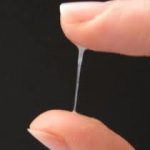Causes of vaginal discharge
Vaginal discharge is common and can occur for a number of reasons. Glands inside your vagina and cervix make small quantities of fluid that are discharged every day. This is normal and experienced by every woman, and it keeps your body healthy. During times of ovulation, sexual excitement or breasting feeding, the liquid can have a stronger white color and be thicker.
 Discharge that occurs after menopause is usually caused by atrophy of the vaginal walls. It is important that medical evaluation take place when the discharge is bloody or is excessive. Infection may be a cause of discharge after menopause and should be diagnosed to begin treatment as soon as possible. Menopause is a stage of life and not a medical condition. The symptoms can be distressing, but in most cases harmless for a woman.
Discharge that occurs after menopause is usually caused by atrophy of the vaginal walls. It is important that medical evaluation take place when the discharge is bloody or is excessive. Infection may be a cause of discharge after menopause and should be diagnosed to begin treatment as soon as possible. Menopause is a stage of life and not a medical condition. The symptoms can be distressing, but in most cases harmless for a woman.
Experiencing a discharge after menopause may be disconcerting, but it is important to discover the cause of the discharge. After menopause, a white, thick discharge may be caused by vaginal atrophy. Estrogen replacement therapy may be used to treat this type of discharge.
After a woman reaches menopause, there is a lack of vaginal fluids produced by the body. This can cause a greater incidence of infection. The vaginal fluids and menstruation acts as protection from infection earlier in life. When there is no longer any protection, infection is more common. This can also be the cause of vaginal discharge after menopause.
Bloody discharge after menopause can be the sign of a more serious medical condition and should be evaluated right away. While it could be a normal reaction to fluctuating hormones, it must be checked out by the doctor to determine the cause.
Types
Menopause is a stage of life that is marked by a cessation of menstruation and declining or cessation of estrogen production. When this occurs, the body responds with symptoms that are a perfectly normal part of the process. These symptoms include vaginal discharge that indicates atrophy of the vaginal walls. This is a treatable condition, but it is important to note that this type of discharge is a normal part of menopause.
Infection and serious illnesses are other causes of postmenopausal discharge that must be examined by a doctor so that treatment can begin as soon as possible. According to Dr. Jelovsek, M.D., it is rather uncommon for a woman to have a chronic yeast infection after menopause. However, it can happen. If a woman is taking hormone replacement therapy (HRT), Jelovsek notes that the dosage might be too low if she is experiencing vaginal discharge. However, keep in mind that taking synthetic estrogen has been associated with increased risks of breast cancer and cardiovascular disease so take this into consideration before taking HRT and certainly before increasing your dosage.
If a woman develops diabetes, which sometimes happens during menopause, this can result in a condition called yeast vulvovaginitis, which is common after menopause.
Bloody discharge after menopause can be a symptom of cancer. This type of cancer can be effectively treated when it is diagnosed as early as possible.
Effects
The discomfort that is experienced by vaginal discharge after menopause can include itching and burning during urination. Once the doctor can evaluate the discharge and determine the cause, treatment can begin and uncomfortable effects will be eliminated or minimized.
Treatment
The treatment for postmenopausal discharge will depend on the cause. An infection can be treated with prescription medication for a bacterial infection. Alternatively, an over-the-counter product can be used to treat a yeast infection. The doctor will determine which type of infection that you have during your exam.
Bloody discharge after menopause may require additional testing or a biopsy to determine the cause of the discharge.
Hormone replacement therapy can be used to treat a discharge that is caused by vaginal atrophy. This is a normal part of menopause that is caused by decreasing or cessation of estrogen production. Estrogen replacement minimizes many of the symptoms of menopause, including vaginal discharge.
Prevention
Using all of the medication that is prescribed for an infection is one way to prevent a reoccurrence of the symptoms. There are also some lifestyle changes you can make to get your body back on the right track. Eating a healthy diet and exercising daily will help your body produce chemicals and hormones at a natural level. Other than those two methods, you can:
• Bathe or shower daily and pat your genital area dry.
• Avoid hot tubs.
• Don’t douche.
• Change your laundry detergent or fabric softener if you think it may be irritating your genital area.
• The latex in condoms and diaphragms and the sperm-killing gels that are used for birth control can be irritating for some women. If you think one of these things is a problem for you, talk to your doctor about other types of birth control.
• Wear cotton underpants during the day. Cotton allows your genital area to “breathe.â€
• After using the toilet, always wipe from front to back. This may help prevent spreading bacteria from your rectal area into your vagina.
Avoid
• Don’t wear underpants at night.
• Avoid wearing tight pants, pantyhose, swimming suits, biking shorts or leotards for long periods.
• Avoid feminine hygiene sprays, colored or perfumed toilet paper, deodorant pads or tampons, and bubble bath.
Many of the other causes of postmenopausal discharge are not preventable, but early identification and treatment are essential.


